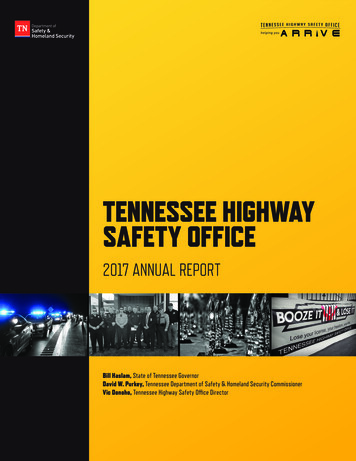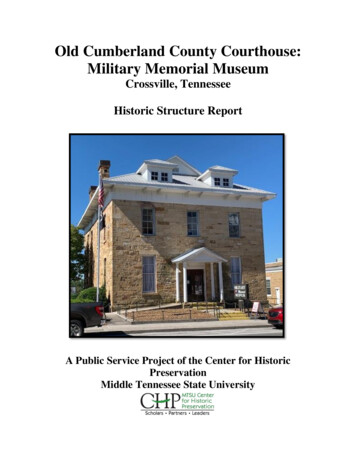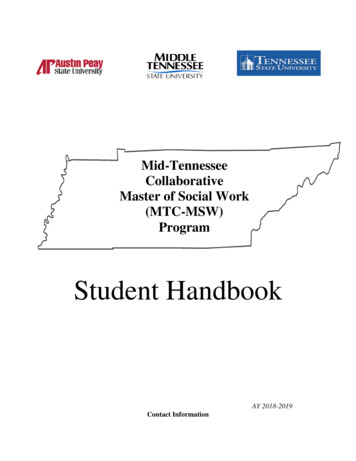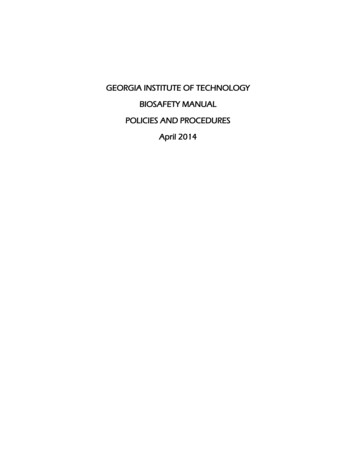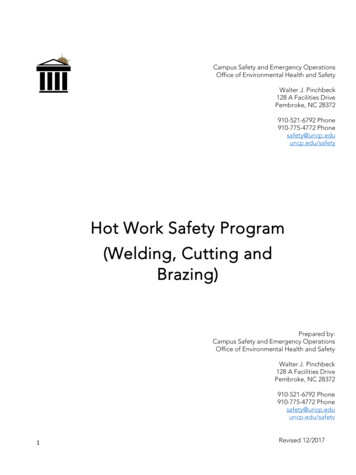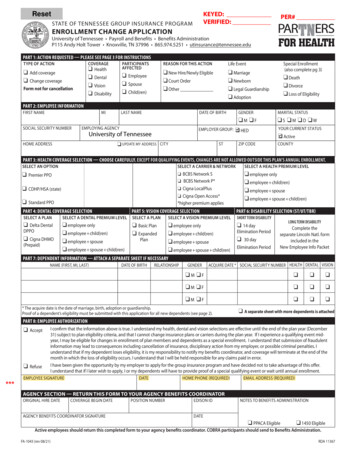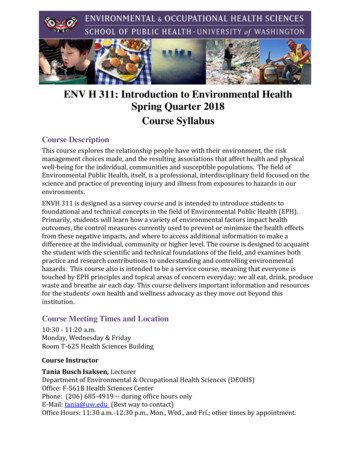
Transcription
Environmental Health and SafetyA GUIDE TO LABORATORY FUME HOODSI.Purposea. Chemical fume hoods are a recognized engineering control and play an important role inlaboratory safety. These devices must be properly designed, installed, maintained andused for optimum control of hazardous substances. These guidelines reflect federal andstate health and safety regulations and policies. The guidelines do not stand alone, butmust be incorporated with other applicable standards into the design and constructionof a fume hood. In this way, those who use and maintain chemical fume hoods will beensured of an adequate level of protection from the possible harmful effects oflaboratory chemicals.II.Scopea. This guide shall address chemical fume hoods used to control hazardous substances inthe laboratory. This plan does not address biosafety cabinets, glove boxes, histologygrossing tables, clean benches, bench-top exhausts, and similar local exhaustventilation.III.Introductiona. Laboratory fume hoods are a type of ventilation system where the primary function is toexhaust chemical fumes, vapors, gasses, dust, mist and aerosol. Fume hoods also serveas physical barriers between reactions and the laboratory, offering a measure ofprotection against inhalation exposure, chemical spills, run-away reactions and fires.b. A typical fume hood has a box like structure with a moveable sash window.Experimental procedures are performed within the hood which is consistently and safelyventilated, usually by means of an extract blower and ductwork. Chemical fumes areexhausted and diluted many times over in the atmosphere and have a negligible effectto human health.c. The hood functions by maintaining a relatively negative pressure in the interior of thehood to prevent any contaminant from escaping while drawing air in through the hoodopening at a consistent rate. A suitable hood face velocity (the speed at which air isdrawn into the hood) is of importance to the safe and effective operation of a fumehood.d. While excessive face velocities can often result in turbulence and reduce containment,insufficient velocities can also compromise hood performance.e. In general, a hood’s face velocity is recommended to be between 0.3 m/s (60 fpm) and0.5 m/s (100 fpm). Most hoods are commonly sized for a minimum face velocity at fullsash opening; but as means to conserve energy some hoods size the minimum facevelocity of the hood at half-sash opening creating new low flow fume hoods, which arenow present in the market.JUNE 20151
IV.Roles and Responsibilitiesa. Laboratory Personnel (including students in classes)i. Review and follow all relevant safety standard operating procedures.ii. Keep work areas safe and uncluttered.iii. Review and understand the hazards of materials and processes in theirresearch/class operations prior to conducting work.iv. If the fume hood is not working properly the individual must immediately stopwork and report the malfunction to the supervisor.b. Principle Investigator/Faculty/ Laboratory Supervisori. The Principal Investigator (PI)/Faculty/Laboratory Supervisor has responsibilityfor the health and safety of all laboratory personnel and students working undertheir authority or within their research facilities.ii. Know the applicable health and safety rules and regulations, training andreporting requirements, and standard operating procedures associated withchemical fume hood use.iii. Notify Facilities Services via a work order request as soon as possible and stopwork when fume hoods are not operating properly.c. EHSi. Administer and oversee the implementation of the Guide to Laboratory FumeHoods.ii. Conduct annual inspection of fume hoods.V.Laboratory Designa. Fume hoods should be located so that persons exiting the lab do not have to pass infront of the hood.i. Potentially dangerous portions of experiments are usually conducted in a fumehood. Many lab fires and explosions originate in fume hoods. A fire or explosionin a fume hood located adjacent to a path of egress could trap someone in a lab.Also, turbulence from passing traffic can adversely affect hood performance.b. Windows in labs containing fume hoods must be closed.i. Breezes coming in through open lab windows can adversely affect the properfunctioning of a hood. Turbulence caused by these wind currents can easilybring the contaminated air inside the hood out into the lab. Note that hood facevelocities are only about 1 mile/hr.VI.Fume Hood Basicsa. A chemical fume hood is a partially enclosed workspace that is exhausted to the outside.When used properly, hazardous gases and vapors generated inside the lid are capturedbefore they enter the breathing zone. This serves to minimize the exposure to airbornecontaminants. The common parts of a fume hood and their major functions are: Hood Body-The visible part of the fume hood that serves to contain hazardousgases and vapors. Baffles-Moveable partitions used to create slotted opening along the back ofthe hood body. Baffles keep the airflow uniform across the hood opening,thus eliminating dead spots and optimizing capture efficiency.JUNE 20152
Sash-By using the sash to adjust the front opening, airflow across the hoodcan be adjusted to the point where capture of contaminants is maximized.Each hood is marked with the optimum sash configuration. The sash should beheld in this position when work involving the fume hood is being performedand closed completely when the hood is not in use.Airfoil-Found along the bottom side edge airfoils streamline airflow into thehood, preventing the creation of turbulent eddies that can carry vapors out ofthe hood. The space below the bottom airfoil provides source of room air forthe hood exhaust when the sash is fully closed.Work Surface-the area under the hood where chemicals are placed for use.Exhaust Plenum-an important engineering feature, the exhaust plenum helpsto distribute airflow evenly across the hood faceFace- the imaginary plane running between the bottom of the sash to thework surface. Hood face velocity is measured across this plane.VII.Fume Hood TypesThere are many types of hoods, each with its own design and function. To identify which hood type ispresent in your lab, a list of definitions describing hood features and their advantages and disadvantagesis provided below.a. Conventional Hood- This term is used to describe a constant air volume (CAV) hood, anolder, traditionally less elaborate hood design used for general protection of thelaboratory worker. Because the amount of exhausted air is constant, the face velocity ofa CAV hood is inversely proportional to the sash height. That is, the lower the sash, thehigher the face velocity. CAV hoods can be installed with or without a bypass provisionwhich is an additional opening for air supply into the hood.b. Walk-in Hood/Floor Mounted Fume Hood- Used for applications which require largeapparatus. As the name implies, these hoods are floor mounted without any worksurface. This facilitates the transfer of equipment and materials into, and out from thehood. Walk-in hoods require a specific written operating protocol.JUNE 20153
c. Fume exhaust connections: “snorkels”- Designed to be somewhat mobile allowing theuser to place it over a small area needing ventilation. However for optimal efficiency,these connections must be placed within six (6) inches of an experiment, process, orequipment. These funnel-shaped exhausts aid in the removal of contaminated orirritating air from a point source to the outside.d. Canopy hoods- Horizontal enclosures having an open central duct suspended above awork bench or other area. Canopy hoods are most often used to exhaust areas that aretoo large to be enclosed within a fume hood. The major disadvantage with the canopyhood is that the contaminants are drawn directly past the user’s breathing zone.e. Glove boxes- Used when the toxicity, radioactivity level, or oxygen reactivity of thesubstances under study pose too great a hazard for use within a fume hood. The majoradvantage of the glove box is protection for the laboratory worker and the product.However, some glove boxes/glove box designs cannot be used with volatile chemicals.f. Perchloric acid and volatile radioisotope hoods- This hood type has wash-downcapabilities to prevent the buildup of explosive perchlorate salts within the exhaustsystems. Perchloric acid and volatile radioisotope work require specific fume hood useprotocols.g. Ductless Fume Hood- Utilize activated carbon filtration to adsorb chemical vapors andfumes. These hoods recirculate air to the laboratory, and are growing in popularitybecause of energy savings. One disadvantage is that these hoods can only be used withcertain chemicals.h. Not Fume Hoods- Biological safety cabinets, laminar flow clean benches, and gloveboxes (see information about glove boxes in (e)) are sometimes mistaken for fumeJUNE 20154
VIII.hoods. These devices utilize particulate filters which do not remove chemical vapors.With specific rare exceptions, they should not be used for work involving chemicals.Fume Hood Safetya. To ensure safety and proper fume hood performance, follow these guidelines:i. Confirm that the hood is operational. Make sure the switch is in the “on”position and the airflow is working properly. To test the airflow hold a tissue orother light weight paper up to the opening of the hood. The paper should bepulled inward.ii. A laboratory fume hood should have a minimum of 2.5 linear feet of hood spaceper person.iii. Equipment and other materials should be placed at least six inches behind thesash.1. This will reduce the exposure of the person to chemical vapors that mayescape into the lab due to air turbulence.iv. Work with the sash at least at optimum height or as far down as practical. Somefume hoods have arrows. The arrows on these fume hoods indicate optimumheight. When the fume hood is not in use, pull the sash all the way down.v. Do not keep loose papers, paper towels, or tissues in the hood. These materialscan be drawn into the blower and adversely affect the performance of thehood.vi. Never place your head inside the hood.vii. Do not block the baffle area of the fume hood. Elevate large equipment twoinches off the base of the fume hood to allow proper ventilation around theequipment.viii. DO NOT use the fume hood as a storage cabinet for chemicals. Excessive storageof chemicals and other items will disrupt the designed airflow in the hood.ix. Use extreme caution with ignition sources inside the fume hood.x. Avoid cross drafts and disruptive air currents on front of the fume hood. Aperson walking past a fume hood can create competing air currents at the hoodface, causing vapors to flow out. Other sources of competing air currents suchas open windows and fans should be avoided while using the fume hood.xi. Clean up spills in the fume hood immediately.xii. Wear personal protective equipment, as appropriate.xiii. Have a general awareness of the operation of your hood and be aware of anydifferences in smell, visual or audible cues that may imply a change in function.xiv. In case of an emergency, notify the appropriate personnel.IX.InspectionsTo ensure that any contaminants in the lab will be exhausted through the fume hood and not escapeinto the hallway fume hood test are performed. The face velocity, average velocity at which the air isdrawn through the face to the hood exhaust, is measured by using an anemometer. The ideal averageface velocity is 100 feet per minute (fpm) for most operations. Ideally, no measurements should beplus or minus 20% of the average.a. Fume hoods should also be tested in the following circumstances:i. Annually;ii. When an employee request an inspection;iii. When a procedural change requires a hood upgrade;JUNE 20155
iv. After a major repair.b. Fume hoods that are newly installed shall be tested prior to use by an independentcontractor using the ANSI/ASHRAE Standard 110 Method of Testing Performance ofLaboratory Fume Hoods.i. Documentation of this test must be sent to Environmental Health and Safety(EHS) prior to using the fume hood.c. Deficient Hoods:i. Chemical fume hoods that do not meet minimum performance standardsshall be tagged out of service by Environmental Health and Safety (EHS).1. Lab workers present at the time of inspection/testing shall benotified of hoods that fail.ii. A work order shall be submitted by the responsible person or a designatedindividual in the lab space.iii. The Department Chair shall be notified immediately of the failure by EHS.X.Maintenancea. In the event that scheduled maintenance is to be done on a fume hood the facultymember, lab supervisor, or department head should be notified of the day and time ofwork to be done in advance.i. The notification will instruct lab personnel to shut down all processes anddiscontinue all activities in the fume hood if necessary.b. When the maintenance is completed, Facilities Services must notify faculty member, labsupervisor, or department head the when the work is complete and the exhaustsystems are operating normally.XI.Power Failurea. In the event of a power failure to the fume hoods, lab personnel should follow thefollowing plan:i. Shutdown all processes and discontinue all activities in the fume hood;ii. Contain or remove all hazardous materials;iii. DO NOT use the hoods;iv. If toxic fumes have entered the room evacuate the building and call 911.XII.ReferencesNFPA 45 Section 6-4.5OSHA 29 CFR 1910.1450ANSI/AIHA Z9.5-2003National Research Council: Prudent Practices in the Laboratory, Handling and Disposal of ChemicalsUniversity of Tennessee Knoxville, Department of Environmental Health and Safety: Safety ManualUniversity of California Santa Barbara: Chemical Fume Hood GuideCentre College: Fume Hood GuidelinesNorthwestern University: The Chemical Fume Hood HandbookEsco: A Guide to Laboratory Fume HoodsJUNE 20156
e. In general, a hood's face velocity is recommended to be between 0.3 m/s (60 fpm) and 0.5 m/s (100 fpm). Most hoods are commonly sized for a minimum face velocity at full sash opening; but as means to conserve energy some hoods size the minimum face velocity of the hood at half-sash opening creating new low flow fume hoods, which are
